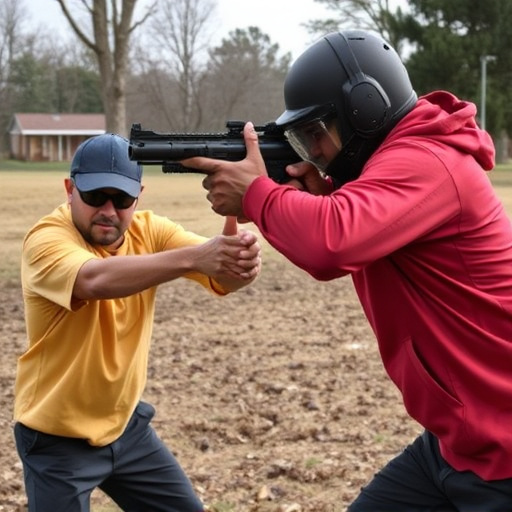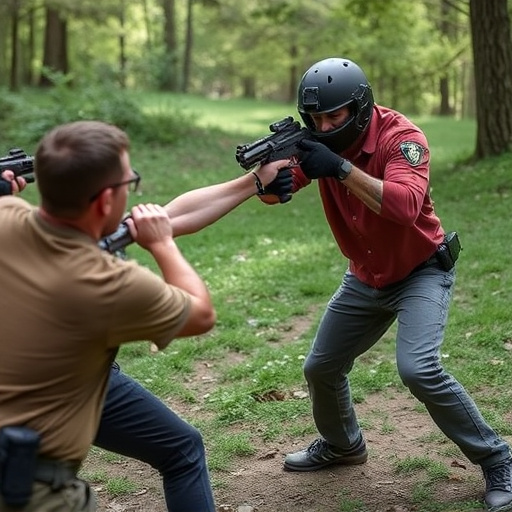Stun guns have a limited effective range of 5-30 feet, debunking myths of long-range effects. While they cause temporary paralysis and disorientation, studies show potential neurological side effects including altered consciousness, memory issues, and cognitive deficits. Global regulations control stun gun energy output and range to mitigate these risks, with safety protocols and training mandated for responsible use.
Stun weapons, often glorified as non-lethal alternatives, have sparked debates due to their increasing accessibility and potential for misuse. Beyond the widely discussed physical stunning effects, this article delves into the lesser-known neurological impacts of stun gun projectiles. We separate fact from fiction regarding their range capabilities while exploring the regulatory frameworks in place—or lacking—to control their reach. Understanding these aspects is crucial in gauging the true potential and side effects of stun weapons.
- Stun Gun Projectile Range: Fact vs Fiction
- Neurological Impacts: Beyond Physical Stunning
- Regulatory Frameworks: Controlling Stun Weapon Reach
Stun Gun Projectile Range: Fact vs Fiction

Stun gun projectile range is a topic that often sparks confusion and misinformation. Contrary to popular belief, stun guns are not like traditional firearms with set bullet trajectories or long-range capabilities. The effective range of a stun device is typically much shorter—ranging from 5 to 30 feet (1.5 to 9 meters), depending on the model and power output. This range is designed to enable close-quarters incapacitation, not long-distance confrontation.
The notion of stun guns causing significant neurological side effects over distance is largely fiction. Stun devices work by delivering an electric shock that overrides motor functions, leading to temporary paralysis and disorientation. However, the electrical current dissipates rapidly with distance, significantly reducing its impact after a few feet. Unlike bullets or other projectiles, the energy transfer isn’t consistent beyond the immediate range, making the idea of long-range stun gun effects a myth. Understanding these facts is crucial when considering the practical applications and limitations of stun weapons.
Neurological Impacts: Beyond Physical Stunning

While stun weapons are primarily known for their ability to temporarily incapacitate individuals through physical stunning, they can also have significant neurological impacts. Beyond the immediate effects of muscle paralysis and disorientation, stun guns can cause complex changes in brain function. These include altered consciousness levels, memory lapses, and even long-term cognitive issues. The electrical impulses emitted by stun devices can interfere with neural communication, leading to a range of neurologic side effects that may not be immediately apparent.
Studies have shown that exposure to stun weapon energy can result in acute neurological symptoms such as headaches, dizziness, and confusion. Chronic exposure or repeated shocks could potentially lead to more severe consequences, including persistent cognitive deficits and even structural brain changes. As such, the neurological aspects of stun gun use should not be underestimated, emphasizing the need for responsible and regulated deployment of these devices to mitigate potential long-term health risks.
Regulatory Frameworks: Controlling Stun Weapon Reach

The regulatory frameworks surrounding stun weapons, including their projectile range capabilities, vary significantly across jurisdictions. These laws are designed to balance public safety with individual rights and privacy. In many countries, stun guns and similar devices are classified as less-lethal or non-lethal weapons, subject to specific regulations that dictate their use, possession, and sale. These regulations often include restrictions on the energy output, projectile range, and the authorized users—typically law enforcement agencies and in some cases, licensed individuals for self-defense purposes.
Controlling the reach of stun weapons is crucial not just for public safety but also to mitigate potential neurological side effects associated with their use, such as temporary paralysis or disorientation. Regulatory bodies often mandate specific safety protocols, training requirements, and record-keeping mechanisms to ensure responsible deployment. These measures aim to prevent abuse, accidental harm, and the escalation of situations that could lead to unnecessary injuries or fatalities.
The discussion on stun weapon projectile range has revealed a complex interplay between technology, regulation, and public safety. While stun guns are often marketed with impressive reach claims, it’s crucial to differentiate fact from fiction. Beyond the physical stunning effects, understanding the neurological impacts of these weapons is essential for informed decision-making. Regulatory frameworks play a vital role in controlling their reach, ensuring they are used responsibly. By considering both the technological capabilities and potential side effects, we can foster a safer and more effective approach to law enforcement tools, prioritizing public welfare above all else.
